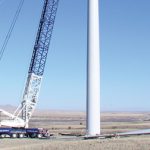You can’t talk about wind power without talking about coal—not in Ontario, Canada, anyway. As concerns about North America’s dependence on fossil fuels have increased over time, legislation is beginning to catch up. But no legislation has yet matched the ambitious goals of Ontario’s 2009 Green Energy Act (GEA). Focusing on the creation of a consistent supply of energy from non-coal sources, the GEA paints a picture of how the province will meet their own forced deadline for eliminating the use of coal for power generation by 2014. Stated simply, Ontario is kicking the coal habit, and wind power has already become a core component of the new power supply mix.
Dr. Hermann Scheer—the former general chairman of the World Council for Renewable Energy who passed away in 2010—noted when the legislation passed that “Ontario’s Green Energy Act represents North America’s most ambitious and far reaching enabling legislation and will place Ontario as a world leader in renewable energy development, industrial innovation and climate protection.”
This leadership created a high growth market for wind power generation nearly overnight. Already close to a million homes and businesses are powered by electricity created from wind across Canada. Ontario itself currently produces enough electricity to power more than 300,000 homes—a figure that is expected to be surpassed by 2014, once the GEA’s impact has come to fruition.
With the clock loudly ticking, energy producers and manufacturers including WindTronics are flocking to the province to help build the infrastructure that will deliver the new, renewable power supply mix. With this homegrown demand fueling new factories and the innovation necessary to reach these ambitious goals, Ontario is leading the effort to find new ways to produce and deliver energy from wind and other clean sources of power. This includes manufacturing the components needed to do so, and in transforming a power delivery grid to work with the new renewable power source mix.
A Kinder, Gentler Approach
Taking away coal as a fuel to generate electrical power without replacement energy sources in place would have been akin to “going cold turkey” to cure an addiction. Ontario is providing the government the support necessary to create a viable market for green energy producers and affiliated manufacturers. The 50,000 jobs expected to be created by these utilities and manufacturing enterprises are also expected to contribute substantially to the economic development of the region.
Broadly, bringing on new sources of clean energy and attracting new investment is part of the province’s “Open Ontario Plan” to create jobs and strengthen the economy. Ontario’s clean energy plan is getting Ontario off smog-producing coal and onto cleaner energy sources like wind, solar, and bio-energy. These projects are an important part of the plan, which is making Ontario a global clean energy leader and has sparked a new industry within the province. On the ground this means job creation to build, connect, and create the new infrastructure that will produce and deliver electrical power from clean and green sources such as wind power. Figure 1
To make this transformation from coal to green power a less painful journey, the GEA combines a “Feed-In Tariff” (FIT) system that strives to make renewable energy production profitable for private sector organizations; to create opportunities for communities to build, own, and operate their own renewable energy projects; and to enact a streamlined approval system for renewable energy projects. As a result, investment from other countries is flowing into Ontario, to build the necessary infrastructure, improve the grid, and manufacture components for energy production.
This transformation is no small undertaking. It is important to note that Ontario is Canada’s largest economy, and the seventh-largest economy in North America, with only six U.S. states producing a higher GDP. Overall economic growth is expected to become increasingly strong every year for at least the next three years, with projections at 2.2 percent growth for 2011, 2.5 percent for 2012, and 2.7 percent for 2013, according to the Ontario Ministry of Finance in 2010.
The Ontario Opportunity
Some of the largest investments in Canadian history were negotiated and confirmed within the first year since the signing of the GEA. Green energy companies across the spectrum began examining the opportunities offered by the GEA, particularly in combination with Ontario’s strategic advantages as a North American center for advanced manufacturing. Figure 2
In March of 2010, the Ontario Power Authority (OPA) announced 510 projects for mid-scale FIT projects (10kW-500kW) with a total generating capacity of 112MW. That announcement was quickly followed by another in April 2010, when the OPA awarded the first FIT contracts for large-scale projects (those exceeding 500 kilowatts). Of the 184 projects, 48 are related to wind power. The remaining awarded contracts include 76 ground-mounted solar photovoltaic programs as well as various biogas, biomass, landfill gas, and rooftop solar projects.
Accelerating Activity
The economic benefits from these projects, many still in launch phases, are just now beginning to filter down to sub-contracting companies. This scale of opportunity is unprecedented in the renewable energy sector.
For the private sector, the legislation has resulted in the award of almost 700 clean energy contracts. For example, in January 2010 Samsung C&T, together with a South Korean consortium, announced they would make the largest renewable energy investment of its kind in the world, and they would do so in Ontario. This agreement consisted of $7 billion to build 2,500MW of wind and solar generating capacity and four manufacturing plants. In return the province guarantees the consortium will receive FIT rates for 20 years, plus additional incentives contingent on the plants meeting operational schedules beginning in 2013. These projects will triple Ontario’s output from renewable wind and solar sources and provide clean electricity to more than 580,000 households. The consortium chose Ontario because the province’s Green Energy Act guarantees stable rates for renewable energy.
Later in 2010, the province announced the creation of two new wind power-related manufacturing facilities resulting from the commitment of Samsung and its consortium. The first, Ontario’s newest wind tower manufacturing plant, is bringing 300 new full-time jobs and up to 400 construction and indirect service jobs to Windsor. The plant will be built and run by a new Ontario-based subsidiary of CS Wind.
Getting a Good FIT
Ontario’s FIT program is generally thought of as the cornerstone of the GEA as it sets stable pricing for suppliers, resulting in the confidence necessary to make large-scale, long-term investments in a market like Ontario.
“The feed-in tariff program is continuing to meet its objective to encourage more renewable energy to be developed in Ontario,” said Colin Andersen, CEO of Ontario Power Authority, in late 2010. “Interest in the program continues to be strong, and Ontario will benefit from the new clean renewable energy that these projects will deliver.” Figure 3
The GEA was specifically designed to accelerate renewable energy production by offering generous FIT rates. The FIT is a core component of the value proposition for investment from the private sector. FIT payments for wind power, for example, are 13.5 cents per kilowatt-hour (c/kWh) for onshore and 19.0 c/kWh for offshore projects. The FIT also includes both a price escalation clause linked to inflation over the 20-year contract and a “price adder” to encourage the development of Aboriginal and community projects. Domestic content requirements were incorporated to fuel the growth of green energy component manufacturing and service sector in Ontario. Wind developers, for example, will be required to have a percentage of their costs come from Ontario goods and labor by the time the projects become operational. The requirement starts at 25 percent, and it increases to 50 percent on January 1, 2012.
Supporting the Supply Chain
Ontario’s many tax advantages apply not only to the large corporations generating power and manufacturing large-scale components, but also to the many middle-market companies that comprise the supply chain. In fact, there is a powerful “one-two” punch that the wind power industry operating in Ontario benefits from: stable pricing plus tax reform legislation. Also in 2009, to further stimulate business investment Ontario launched a comprehensive multi-year tax reform program that covers corporate, personal, and sales taxes. As a result, the marginal effective tax rate on new investment plummeted from 32.8 percent in 2009 to 18.6 percent in 2010 and will continue to drop to 16.2 percent by 2018. These tax cuts are making Ontario one of the most tax-competitive jurisdictions in the world for new investment.
Through tax reform, the GEA, and massive investments in education and infrastructure the government of Ontario is determined to leverage the economic winds of climate change, innovative energy technologies, and globalization to fuel long-term, sustainable job creation and growth. The strategy hinged on winning the support of global investors, whose interest has demonstrated itself in the influx of investment since the legislation took effect.
Aggressive Innovation
The investments by energy producers and manufacturers are expected to significantly expand market opportunities all along the green energy supply chain. They will encourage major manufacturers to begin tooling up for a sustained commitment to supplying the growing sector with parts and technologies. Figure 4
Renewable energy market-focused R&D is also growing in locations like Ontario with strong environmental legislation. The newly-created demand for renewable power fuels growth and investment, which in turn requires R&D in order to maintain industry leadership and meet growth targets. Across the province there are publicly funded R&D labs specializing in advanced materials, engineering, and other fields related to renewable energy. World-leading companies from Magna International, to Goodrich, to Research In Motion (RIM) conduct R&D in Ontario, in part because of the research talent pool and also because the R&D tax credits available in the province are among the most generous in the world.
A Work in Progress
While Ontario’s Green Energy Act was crafted with programs and tax incentives that are unique to Ontario’s economy and needs, the approach has proven itself to be strong enough for replication in other jurisdictions with an interest in creating a market for wind power, and an industry to support that market. The principal that strong legislation, particularly in combination with stabilized pricing for renewable energy, can result in economic growth is a sound proposition, worthy of consideration by communities striving to achieve job growth and environmental leadership.
Consider the change that has already been impacted in Ontario between 2009 and 2011. The number of wind turbines in Ontario has grown from 10 in 2003 to more than 670 by the time the GEA regulations were announced in 2009. Wind output from Ontario’s commercial wind farms reached 2.3TWh in 2009—a 60-percent increase over the previous year.
Ontario now has more than 1,500MW of wind power online generated by more than 800 wind turbines, and that number is expected to reach more than 950 by 2012. In 2003 there were only 15MW of wind power generated by 10 turbines. This is a hundredfold increase in wind power capacity. Ontario coal generation was two-thirds less in 2010 compared to 2003 levels. Ontario’s long-term energy plan forecasts 10,700MW of renewable energy—wind, solar, and biomass—by 2018. This is equivalent to meeting the annual electricity requirements of two million homes.
“More and more clean energy businesses are investing in Ontario and creating jobs,” according to Brad Duguid, minister of energy. “These projects create good jobs and power our homes, businesses, hospitals, and schools while cleaning up the air we breathe.”
The GEA legislation has created more than a market for renewable energy, it’s created a new center of industry. When coupled with the Ontario tax reform package and the province’s general business-friendly culture, Ontario has become not just a place that creates renewable energy for its own consumption, but a business destination for companies that aspire to worldwide leadership. Increasingly, innovation in the delivery, and operations of wind and other forms of renewable power are taking place in Ontario, and not just in production and manufacturing. The province’s public, private, and academic sectors are working together to demonstrate to the rest of the world how to rid a population of its dependence on coal and other fossil fuels and move into an era of clean green power.








































